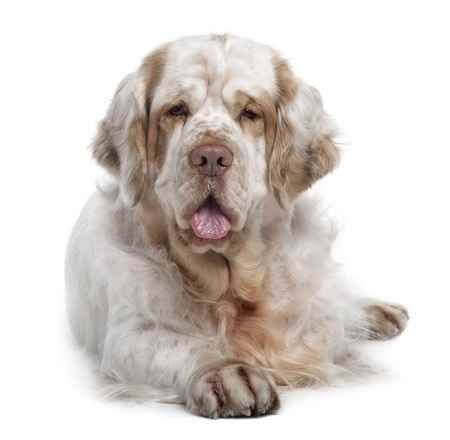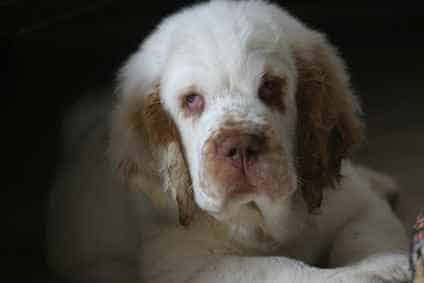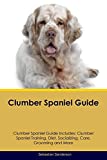The Clumber Spaniel is among the most low-keyed and easy going of the Sporting Dogs, although is still very much a hunter at heart. Indoors, he is quiet calm, gentle and rather lazy. Preferring to curl up on a sofa, they enjoy snoozing and eating.

Clumber Spaniel – Temperament
It is one of the few gun dogs or sporting breeds that do well in an apartment or home in the city. They are not barkers. They still need adequate exercise, but their quiet nature makes them an excellent choice for those living in places with close neighbors.
If given the choice, the Clumber would probably prefer the country or a suburban setting with a large yard but they are considered to be very adaptable.
This breed likes company, and may not do well if left for extended periods of time. A lonely Clumber Spaniel is a bored Clumber Spaniel and with boredom comes destruction. If you do leave him for the day, assure he has plenty of toys and chews. A crate also works well for short periods of time.
Besides being an ideal companion for a hunter, the Clumber Spaniel also makes an excellent pet. They are affectionate, mellow and well behaved. Once mature, they are relatively inactive. Puppies, regardless of the breed will be active and require socialization and early training. They usually become attached to one person in their family.
Considered to be a friendly breed, they are still somewhat aloof with strangers. They make poor watch dogs, and are never aggressive which makes them equally unsuitable for guard duty.
About the Breed
People who own other dogs and even cats can safely introduce a Clumber Spaniel. They get along fine with both as long as they were raised together. Small pocket pets may be viewed as prey, so the Clumber Spaniel should not have access to these types of pets.
Clumber Spaniels are playful and generally dependable with children. They will need early socialization to help them adjust to all kinds of people and situations.
They are relatively inactive which means that they may not make the best playmate for very active kids. They tend to move slowly around the house.

Outdoors they enjoy a long walk on a leash or a leisurely hike through a field. They also do well in the water.
As a hunting dog, they have a natural tendency to retrieve. The prey of choice is pheasant and partridges. When in the field, they are very busy, focused and determined. If not used for hunting, these dogs also excel at tracking, agility, and obedience and makes for a great therapy dog as well.
These dogs have been known to drool and can be snorers.
Clumber Spaniel – Breed History
The Clumber Spaniel is one of the oldest of the spaniels dating back to the18th century. Though the exact origin of the breed is not known, it is likely that late in the 1700s, the now extinct Alpine Spaniel and the Basset Hound were bred along with the possibility of the Pyrenean Mountain Dog (Great Pyrenees) and Saint Bernard.
The breed did not get its name until the time of the French Revolution when the Duc de Noailles of France relocated his kennels to the Duke of Newcastle’s English estate, a 3,800-acre estate, Clumber Park in Nottinghamshire, England.
Feeling threatened by the French Revolution, Noailles eventually perfected the breed here and then presented it during a nineteenth-century dog show.
The English nobility took a liking to this breed because it’s slow-moving, but keen-nosed hunting ability and especially the breed’s ability to retrieve.
They were quiet and able to work alone or in packs. They were known for their good stamina, amazing noses and did very well in dense underbrush.
Several British monarchs have preferred the Clumber Spaniel, including Prince Albert (Queen Victoria’s consort), King Edward VII and his son, King George V.
At the time, the breed was not available to commoners because the nobility would not allow it.
They arrived in America in the late 1800s first to Canada and then to the United States. Their popularity was more in the field than in the show. Remaining virtually unknown to the general population, the breed was recognized by the American Kennel Club in 1884. This made them one of the first nine breeds registered with the AKC.
Today, they remain relatively rare. In the U.S., they ranked 139th in popularity. In the UK, they are recognized as a Vulnerable Native Breed by the Kennel Club.

Vital Statistics
Weight:
Male: 70-85 kg; Female: 55-70 lbs
Height: Male: 19-20 cm;
Female: 17-19 inches
Origin: France but moved to England
Popularity: Rare Breed
Life Span: 10-12 years
Colors & Markings
Colors: White
Markings: Lemon and Orange
Ease of Training
While easy to train, owners maintain that they are obstinate if the mood suits them. Overall, though they are loving, loyal and eager to please. They do especially well with a positive approach to training and respond well to reinforcements such as food or toys.
They do not understand harsh treatment and can be quite sensitive to rough play. When he is happy and excited, he not only wags his tail but his entire rear end!
A long 2 to 3-mile walk daily will meet all of their energy needs and keep them quiet and content indoors.
Protection

Clumber Spaniels are friendly if not reserved with strangers. They are never aggressive. If you need a dog to alert you to the fact that someone is at your door, the Clumber will likely fulfill the job with a short loud bark.
Otherwise, if protection is what you need, then keeping looking for your ideal breed. This one is not for you!
Grooming the Clumber Spaniel
Their coat is slightly wavy, flat, soft and dense. The white color helps hunters locate the dog. They shed a small amount of hair year round, but the majority of shedding occurs twice a year.
They are a large dog but in weight, not height. This means that they are close to the grown and their lovely white coat can get filthy after a walk outdoors.
They need to be brushed and combed about two or three times a week. This will cut down on the amount of shedding as well as promote healthy coat growth. A pin or bristle brush, metal comb, and a slicker brush are recommended by owners.
Bathing is required when needed, but if the Clumber Spaniel is outdoors frequently, to keep the white coat gleaming, bathing may need to occur more often. Professional grooming may be need occasionally.
Their ear shape and the way they hang make them prone to ear infections. Ears should be regularly cleaned and any excess hair from under the ear trimmed out to help stop overheating which encourages yeast type infections. If there is any noticeable smelly dark discharge or the ear canal appears red or swollen, call your veterinarian. They may have a fungal or bacterial infection.
Likewise, any dog that seems to be shaking his head or scratching his ears may have a problem that needs attention. Their eyes should regularly be inspected and any debris wiped out with a cotton ball or tissue dipped in warm water. Alternately you can use a face or eye wash.
Sometimes knots form between the toes and must be removed using clippers or blunt tipped scissors.
Keeping the hair trimmed between these toe pads is a good idea to prevent any mats from forming. Not only is it a grooming issue, but it also becomes uncomfortable to the dog when hair is being pulled into knots.
Thick hair between the toes can be painful especially if mud or snow/ice becomes attached. A dog that is favoring a paw may have mats between his toes.
Teeth need to be brushed with a canine toothpaste and toothbrush. If done regularly, you will save money in the long run from costly professional dental cleanings done at the veterinary hospital.
Start when the puppy is young to help him get used to having his mouth opened and teeth examined. Work up towards brushing as the puppy will allow.
Puppies need to be trained to tolerate and enjoy grooming. Regular grooming from the day you bring your Clumber home will help acclimate them to the process making grooming an enjoyable activity for both of you. Puppies will need to be brushed, trimmed and have their nails clipped.
Health Considerations
All dog breeds have certain conditions that are likely genetic in nature and have been identified as occurring in the breed. No one dog will ever be plagued by all of these circumstances.
Do not become frightened when you read the list. Sometimes breeds that have a long list of health issues just have a parent club that is more diligent about collecting data.
Awareness of what can happen will make you a better dog parent because you will be equipped to deal with them should they arise.
Anal Gland Impaction
Impacted anal glands can be seen in any breed but have been identified as being a problem in Clumber Spaniels. When the anal glands become impacted, the dog is uncomfortable and may drag his rear along the ground to relieve the itchy feeling.
Dogs that have a decent amount of fiber in their diet will have a healthy GI tract. The sacs or glands will release a little of the fluid in them each time the dog defecates.
If this does not happen, the fluid can get thick and pasty making it difficult to express. When this happens, the glands or sacs need to be expressed by hand, usually by a vet.
Autoimmune Hemolytic Anemia
This can be a life-threatening condition where the body attacks its own immune system, causing a profound anemia. Most common symptoms lethargy and the dog may not get up and move around. If you notice these symptoms, call your veterinarian.
Colitis
Colitis is the inflammation of the colon. Feces tend to be soft and may contain blood and mucus. The dog appears to be healthy in all other respects. This can often be managed with a change of diet. Dog foods that formulated for pets with sensitive stomachs may be recommended.
Dry Eye
With dry eye, the dog fails to produce tears. As the cornea dries, the surface of the eye becomes covered with a gray, sticky mucus. It is essential to keep the eye area clean, and artificial tears with anti-inflammatory drops will be needed to control the condition.
Ear Infections
Ear infections are common in all breeds of dogs that have ears that hang down. There is little ventilation in the ear canal providing a warm dark place for bacteria to multiply. Odor, excessive wax, even blood accumulates in the ear.
The dog may shake his head or scratch. When it progresses to this stage, the veterinarian will prescribe ear cleaners and drops.
Ear infections can be prevented by regular cleaning and clipping away the hair from the inside of the ear flap.
Entropion
Entropion results when the edge of the eyelid rolls inward towards the eye causing lashes and hairs to irritate the cornea. Surgery may be required to correct the problem.
Hip Dysplasia
This is a very common health problem in most breeds especially the larger breeds. It can cause discomfort or pain and affects how the dog walks.
The head of the femur (hip joint) does not fit properly into its socket. Mild cases may involve the use of medication for pain and inflammation. Severe cases usually require surgery.
Adult dogs used for breeding can be checked by the use of x-rays.
Intervertebral Disc Disease
Disc disease seems to be most common in middle-aged dogs and in breeds that have long backs. Discs are the soft structures made of cartilage that is found between each spinal vertebrae. Their purpose is to allow movement of the spine. If a disc ruptures, the fluid within the disc is squeezed onto the spinal cord and nerves causing pain and inflammation.
Less severe cases may respond to medication but others require spinal surgery. Some dogs can become paralyzed in the hind quarters.
Skin Allergies
Most skin allergies are as a result of a reaction to something in the dog’s environment and may occur seasonally, intermittently or may become chronic.
The most common types of irritations include fleas, mites, or bacteria. The skin becomes sensitized to some material in the environment. Food allergies can also cause skin irritations. Treatment depends on the cause of the allergy.
Umbilical Hernia
An umbilical hernia occurs where the umbilical cord was attached to the puppy from the placenta. An opening in the abdominal wall does not close completely and sometimes fat protrudes. It is a hole or rupture in the body wall, through which abdominal fat protrudes.
If the hole is large enough for a loop of intestine to pass through, then it will be necessary to have it surgically repaired to prevent a hernia becoming ‘strangulated’.
Suggested Reading
Click on the images for further information to help you decide if the Clumber Spaniel is the breed for you!





